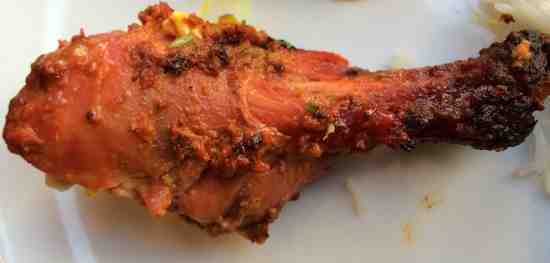
I keep reading articles in Indian newspapers about an obesity epidemic ravaging India.
Plus, diabetes rates are said to have tripled, quadrupled or whatever the next higher number is.
Like most folks, I too thought that fat Rakesh Gupta and obese Senthil Kumaran were fat because undisciplined, gluttonous Rakesh and Senthil eat more Tandoori Chicken, Paneer Tikka Masala, Dum Biryani and Medhu Vada than the rest of us lean and mean disciplined Patels and Iyers do.
About Bollywood star Sonakshi Sinha’s weight issues what can I say that has not been said before.
If you believe all the nasty things evil journalists write about her, Sonakshi Sinha is a full-time eater and a part-time Bollywood actress.
One black-hearted blogger described Sonakshi as Bollywood’s “Heavyweight Champion.”
Some of Sonakshi’s mean Bollywood rivals go so far as to say that “Heavyweight Sonakshi” eats more in a single weekend than leggy Bangalore beauty Deepika Padukone consumes in a whole month!
Different Theory
So I was more than surprised to read an article in the New York Times the other day that posits an entirely different theory about the relation between eating and obesity:
But what if we’ve confused cause and effect? What if it’s not overeating that causes us to get fat, but the process of getting fatter that causes us to overeat?
The more calories we lock away in fat tissue, the fewer there are circulating in the bloodstream to satisfy the body’s requirements. If we look at it this way, it’s a distribution problem: We have an abundance of calories, but they’re in the wrong place. As a result, the body needs to increase its intake. We get hungrier because we’re getting fatter.
….According to this alternative view, factors in the environment have triggered fat cells in our bodies to take in and store excessive amounts of glucose and other calorie-rich compounds. Since fewer calories are available to fuel metabolism, the brain tells the body to increase calorie intake (we feel hungry) and save energy (our metabolism slows down). Eating more solves this problem temporarily but also accelerates weight gain. Cutting calories reverses the weight gain for a short while, making us think we have control over our body weight, but predictably increases hunger and slows metabolism even more.
In other words, fat Rakesh Gupta and obese Senthil Kumaran are not fat because they’re eating more Tandoori Chicken and Dum Biryani.
Au contraire, Rakesh and Senthil are stuffing themselves with more Tandoori Chicken and Dum Biryani because they’re fat and getting fatter and in the process not getting the metabolic fuel they need to sustain themselves.
If the alternative view is proven right, the conventional view that obesity is a result of calorie imbalance may be wide off the mark. Issues of personal responsibility for weight problem go for a toss if your body is not getting enough metabolic fuel!
Now you really can’t lash out at Sonakshi Sinha for adding more weight to her already weighty self and snidely refer to the actress behind her fat back as a Bihari cow.
Can you? You still do? How Mean!
If all the Tandoori Chicken, Chicken Makhani and Paneer Tikka Masala that Sonakshi gorges on are getting stored as fat instead of serving as her metabolic fuel, what else can that bechari do except stuff herself with more Tandoori Chicken, Chicken Makhani and Paneer Tikka Masala.
The NYT article notes that high insulin levels, triggered by high carbohydrate consumption, may be causing obesity. It seems we’re consuming more refined carbohydrates now than in the 1970s.
Let’s not forget here that Sonakshi Sinha is a child of the late 80s (June 2, 1987 if you insist on knowing the exact day she landed). So high refined carbohydrate consumption could certainly be the bigger villain in her life than all the bad lecherous guys she had to contend with in Dabbang, Rowdy Rathore etc.
The New York Times piece on obesity and hunger is based on an article in the Journal of American Medical Association – Increasing Adiposity Consequence or Cause of Overeating?
Here’s what the Journal of American Medical Association has to say:
According to an alternative view, chronic overeating represents a manifestation rather than the primary cause of increasing adiposity. Attempts to lower body weight without addressing the biological drivers of weight gain, including the quality of the diet, will inevitably fail for most individuals.
Here are the two Models of Obesity as described by researchers in the Journal of the American Medical Association:

So the next time you see Rakesh Gupta or Senthil Kumar have some compassion for these poor fat slobs. Their weight problem may not be of their making.
As for me, when I see fat Sonakshi waddling on the screen in the forthcoming Bollywood movie Holiday with Akshay Kumar, I promise not to cringe but send out a few loud whistles in admiration for the doughty manner in which she’s been tackling the weighty problems of her life – By gorging on more Tandoori Chicken and Chicken Makhani in a single weekend than slim Deepika Padukone consumes in six months.

Sounds like vicious circle to me, being fat makes you eat more, making you fatter.
The question is how do we break this circle?
Exercise may help a little, make you fit but doesn’t really cause fat loss unless you do it everyday for many hours and do that for many years.
I am talking about really overweight people you mentioned like Sonakshi who is certainly fat especially for her age.
It only gets worse and harder with age.
SearchIndia.com Responds:
Eat less refined carbohydrates and pray that medical researchers make some breakthroughs soon.
The prevailing model seems to fit my case – not sure if the alternate model is universal, or is only for select cases.
The trick is to not cut down on fatty food.
Once we start cutting down on fatty food, the body experiencing a fat shortage, tries to adapt by converting other forms to fat, and storing it for the rainy day.
And of course, burning the calories definitely helps.
SearchIndia.com Responds:
1. You write: The prevailing model seems to fit my case – not sure if the alternate model is universal, or is only for select cases.
The alternative model hypothesis suggested by medical researchers seems to have near universal applicability within the context of obesity.
2. You write: Once we start cutting down on fatty food, the body experiencing a fat shortage, tries to adapt by converting other forms to fat, and storing it for the rainy day.
Under normal circumstances, the “rainy day” argument would make sense.
But I don’t think the “rainy day” argument is that relevant within the context of obesity crisis.